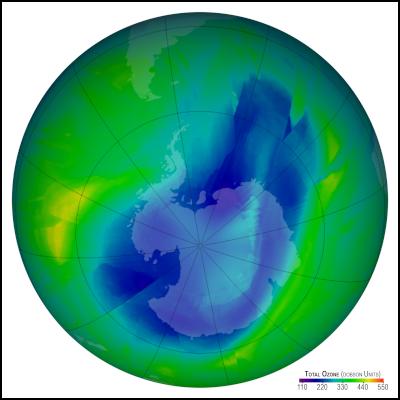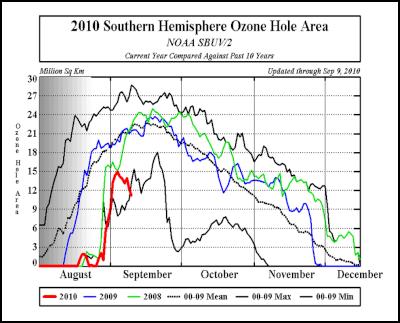Whatever happened to the ozone hole?

Whatever happened to the ozone hole?
This year’s ozone hole season is “slow to kick in,” says NIWA atmospheric scientist, Dr Olaf Morgenstern.
[Look at our fantastic images of this year’s ozone hole. http://ftpmedia.niwa.co.nz/OZONE/]
In New Zealand the official ozone hole season starts in the second week of September and runs through to November.
Despite the small size of this year’s ozone hole, scientists cannot yet say whether this ozone hole season marks the start of a sustained recovery of the Antarctic ozone layer. “There is no sign of the ozone hole shrinking nor is there any significant recovery just yet,” says Dr Morgenstern. After all, the largest-ever ozone hole occurred only four years ago in 2006, and there are substantial year-to-year variations in its size.
The ozone layer is set to recover at different speeds in different parts of the globe.
So, what is ozone and why do people care about it?
Ozone is an oxygen compound that is constantly formed and destroyed in our atmosphere. The layer of life-protecting ozone found in the lower stratosphere protects, the Earth's surface, atmosphere, and sea - everywhere that is inhabited by living things - from excessive ultraviolet (UV) radiation.
Until the 1980s, chlorofluorocarbons, or CFCs, and other man-made halogen compounds were used in refrigeration, aerosol sprays and numerous other applications throughout the world. UV radiation breaks down these chemicals once they are in the stratosphere, releasing chlorine and bromine atoms, which then deplete ozone.
With the introduction of the Montreal Protocol in 1987 there was agreement to phase out the usage of these chemicals. This agreement also provides for ongoing research into, and observations of, ozone and related compounds. NIWA scientists have contributed to this research by participating in a coordinated international modelling activity, called CCMVal.

What can we expect in the future?
The CCMVal has led to new insights into how the ozone layer will likely evolve in different parts of the world during this century.
“In the future we expect [ozone] to recover,” says Dr Morgenstern. “We might have more ozone over New Zealand than we had say fifty years ago, we might have less UV, and fewer skin cancers.”
The tropics are set to partially recover from the limited ozone depletion observed there but then decrease again in the second half of this century.
In northern mid
latitudes and in the Arctic in spring, ozone is set to
return to 1980 levels by around 2020-30 and to further
increase after that.
At southern mid latitudes, including over New Zealand, ozone will recover more slowly than in the North, with ozone returning to 1980 levels in around 2040.
At southern high latitudes in spring, the Antarctic ozone hole will take substantially longer to heal. We may have to wait until around 2060 to get back to 1980s levels.
These differences in the speed of recovery are associated with complex processes involving both the removal of halogens (which destroy ozone) from the stratosphere and climate change. The flip side of climate change is that as the troposphere (the lowest part of the atmosphere) is warming, the stratosphere is cooling. This cooling of the stratosphere generally slows down ozone depletion, leading to an increase of the overall abundance of ozone. However, over Antarctica, the cooling leads to more polar stratospheric clouds. These clouds promote ozone depletion, slowing down the healing of the ozone hole.
Climate change also affects transport of ozone and other constituents in the stratosphere. The decrease of tropical ozone in the latter part of this century is attributed to accelerated transport of ozone away from the tropics.
The climate models used to understand these processes and predict where they will lead us in the future are the subject of much international interest and study.
This research is funded by The Foundation for Research, Science and Technology and NIWA.
The CCMVal report can be found at:
www.atmosp.physics.utoronto.ca/SPARC/CCMVAL_FINAL/index.php
ENDS


 Electricity Networks Aotearoa: Traffic Cones Are Increasing The Price Of Power
Electricity Networks Aotearoa: Traffic Cones Are Increasing The Price Of Power Great Journeys NZ: Celebrate The Dark Skies Of Kaikōura With Great Journeys New Zealand
Great Journeys NZ: Celebrate The Dark Skies Of Kaikōura With Great Journeys New Zealand Nozomi Networks: Nozomi Networks Labs Report Finds Wireless Networks Unprotected As Threats To Critical Infrastructure Escalate
Nozomi Networks: Nozomi Networks Labs Report Finds Wireless Networks Unprotected As Threats To Critical Infrastructure Escalate Retail NZ: Citizens’ Arrests Will Worsen Violence In Stores
Retail NZ: Citizens’ Arrests Will Worsen Violence In Stores Science Media Centre: NZ’s Breast Cancer Rates Are Some Of World’s Highest – Expert Reaction
Science Media Centre: NZ’s Breast Cancer Rates Are Some Of World’s Highest – Expert Reaction FIRST Union: Evolution Traffic Management Collapse Highlights NZ’s Impending Infrastructure Crisis
FIRST Union: Evolution Traffic Management Collapse Highlights NZ’s Impending Infrastructure Crisis



